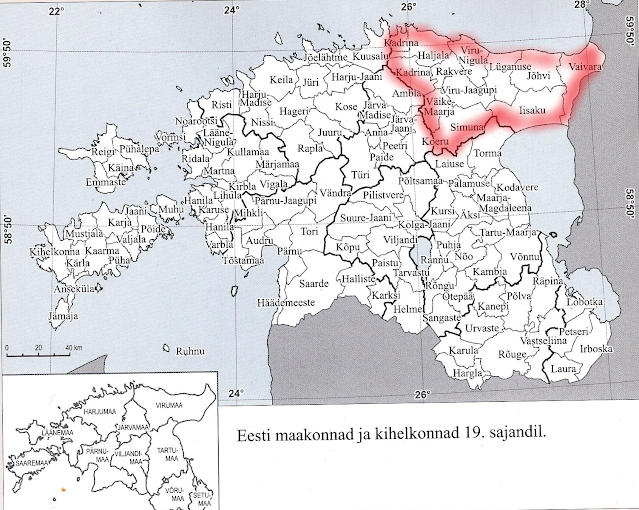Today I would like to continue my exploration of the costumes of Estonia by talking about Virumaa.
 |
This region is found in the northeast of the country. It includes the parishes of Kadrina, Haljala, Rakvere, Viru-Maarja, Simuna, Viru-Jaagupi, Viru-Nigula, Lüganuse, Jõhvi, Iisaku and Vaivara.
https://et.wikipedia.org/wiki/Virumaa
Virumaa was first mentioned in foreign sources from the 11th cent. It has been fought over by the Danes, Germans and others. The language spoken here is North Estonian, which is often referred to simply as Estonian, although the eastern coastal dialects are sometimes considered to form a distinct language.
https://en.wikipedia.org/wiki/Estonian_language
One of the major differences between the Clothing of North and South Estonia is that in the north the chemise was often divided into two garments.
Särk
In Virumaa, the chemise was either sleeveless or had small short sleeves.
Käised
Over the chemise was worn an extremely short garment called 'sleeves'. This was often edged in bobbin lace.
Here is a traditional cut of this garment.
The edge of this garment was often embroidered. White on white or polychrome, counted thread or free form, with or without flat sequins. The embroidery varied quite a bit.
White on white openwork embroidery was one option:
Free form satin stitch in white with flat sequins was also used, like this example.
This style of freeform embroidery was also executed in polychrome. This garment is one of the main focuses of ornament in this outfit.
The hem of this garment hangs free, and the midriff of the chemise underneath is visible.
A full woolen skirt, seelik, is worn over the chemise. It is usually woven with vertical stripes, but horizontal stripes and even plaids or solid colors were not unknown.
The skirt is secured with a sash, vöö. These are woven in many different designs, in a style known all over Scandinavia, the Baltics, and Eastern Europe in general.
Unmarried girls often did not wear an apron, põll, but married women usually did. This was a simple rectangle with attached ties or ribbons which tied around the waist, under the sash. They might be of plain cloth or embroidered or ornamented with galloons.
A short jacket is worn at need, usually plain colored or plaid. This was waist length with a peplum attached. In this image, we see the girl on the left wearing a vest with a similar cut. The vest seems not to have been common.
Annular brooches were used to secure the jackets and the kaised, as in other parts of the Baltic area and Scandinavia. These examples are from Iisaku.
Unmarried girls wore their hair loose, binding it with a headband or putting it in braids to keep it out of the way when working.
Married women wore a linen headdress called tanu, which was often embroidered and trimmed to coordinate with or match the kaised, or sleeves.
In some regions, the skirt and short jacket were made to match, usually in a plaid, like this example from Kadrina.
There was also a newer type of headdress for married women, called pottmütsi. This likely entered Estonia under the influence of Swedish fashion, as these were also popular in Sweden. They consist of a hard shell with silk cloth over it. The Estonian ones were of a different shape than the ones found in Sweden, however.
The long jacket, pikk-kuub, was worn in this region, as in other parts of Estonia and Eastern Europe more widely.
People often went barefoot in warm weather, but in cold weather simple moccasin type footwear of leather, or simple shoes or footwear braided from birch or linden bark were worn. These were generally used all over Eastern Europe. They were later replaced by regular shoes.































































No comments:
Post a Comment